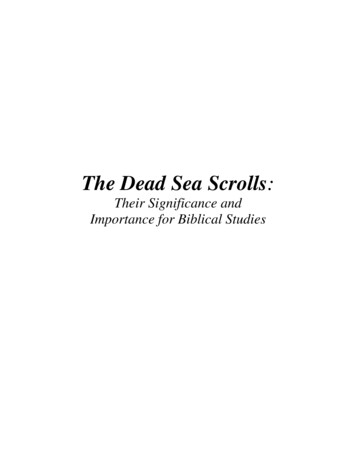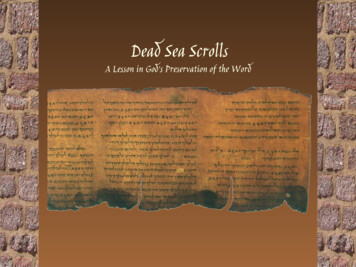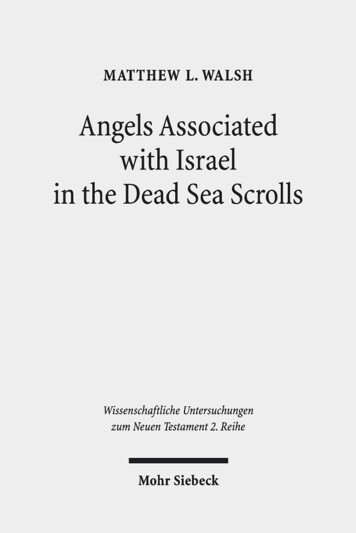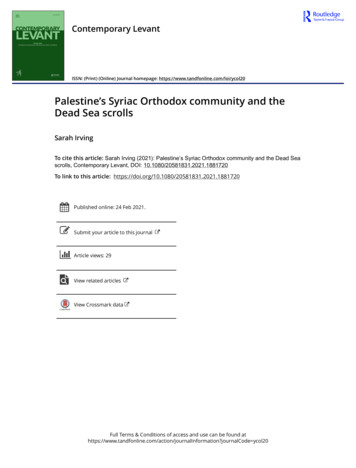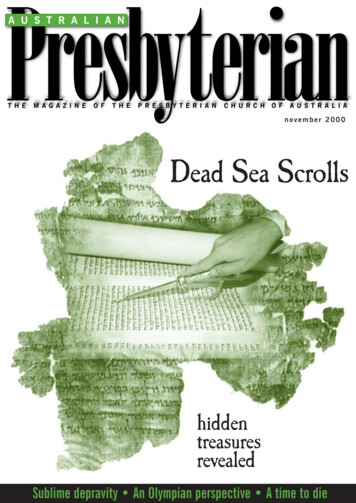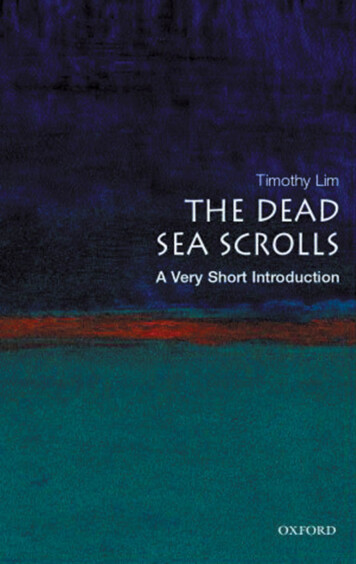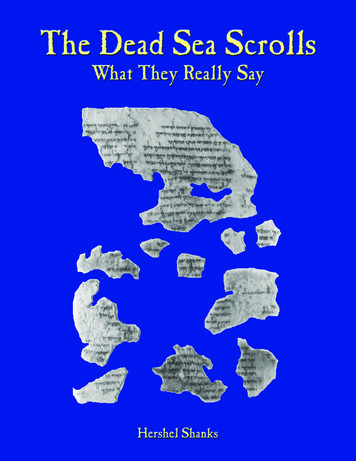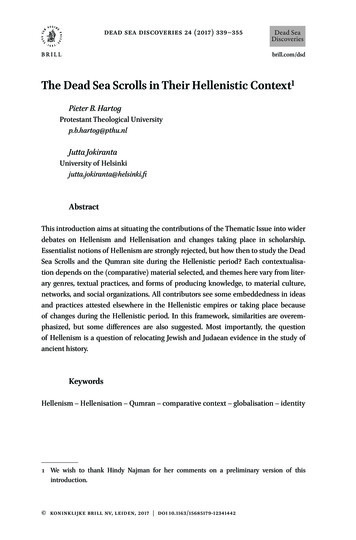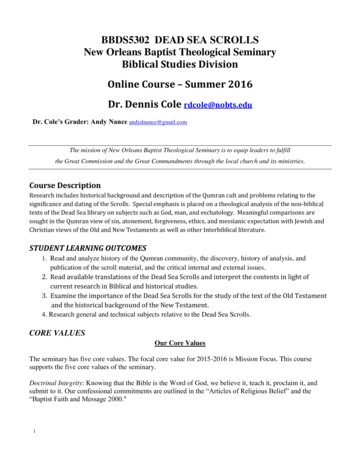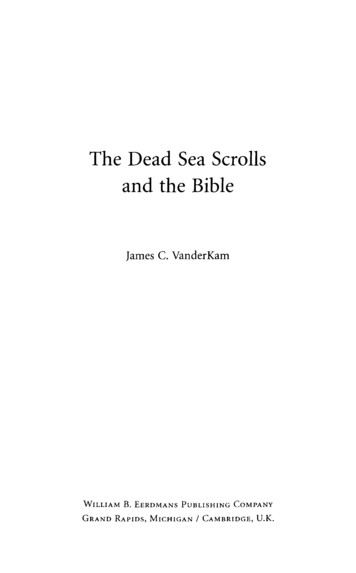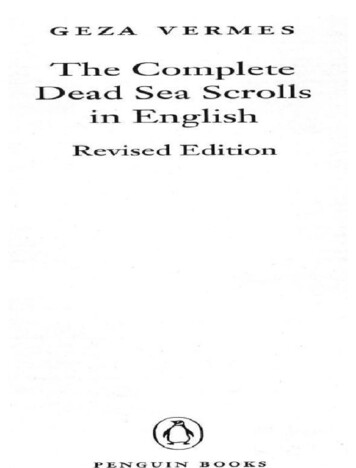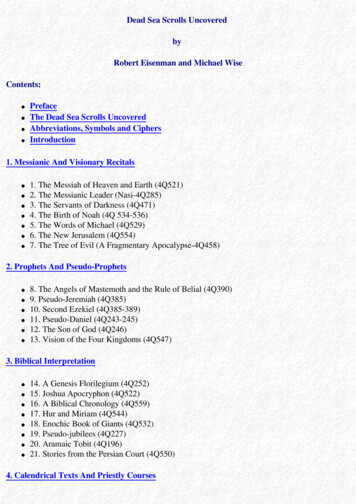
Transcription
Dead Sea Scrolls UncoveredbyRobert Eisenman and Michael WiseContents: PrefaceThe Dead Sea Scrolls UncoveredAbbreviations, Symbols and CiphersIntroduction1. Messianic And Visionary Recitals 1. The Messiah of Heaven and Earth (4Q521)2. The Messianic Leader (Nasi-4Q285)3. The Servants of Darkness (4Q471)4. The Birth of Noah (4Q 534-536)5. The Words of Michael (4Q529)6. The New Jerusalem (4Q554)7. The Tree of Evil (A Fragmentary Apocalypse-4Q458)2. Prophets And Pseudo-Prophets 8. The Angels of Mastemoth and the Rule of Belial (4Q390)9. Pseudo-Jeremiah (4Q385)10. Second Ezekiel (4Q385-389)11. Pseudo-Daniel (4Q243-245)12. The Son of God (4Q246)13. Vision of the Four Kingdoms (4Q547)3. Biblical Interpretation 14. A Genesis Florilegium (4Q252)15. Joshua Apocryphon (4Q522)16. A Biblical Chronology (4Q559)17. Hur and Miriam (4Q544)18. Enochic Book of Giants (4Q532)19. Pseudo-jubilees (4Q227)20. Aramaic Tobit (4Q196)21. Stories from the Persian Court (4Q550)4. Calendrical Texts And Priestly Courses
22. Priestly Courses I (4Q3 2 1)23. Priestly Courses II(4Q32 0)24. Priestly Courses III-Aemilius Kills (4Q323-324A-B)25. Priestly Courses IV (4Q325)26. Heavenly Concordances (Otot-4Q319A)5. Testaments And Admonitions 27. Aramaic Testament of Levi (4Q2 13 -214)28. A Firm Foundation (Aaron A-4Q541)29. Testament of Kohath (4Q 542)30. Testament of Amram (4Q543,545-548)31. Testament of Naphtali (4Q2 15)32. Admonitions to the Sons of Dawn (4Q298)33. The Sons of Righteousness (Proverbs-4Q424)34. The Demons of Death (Beatitudes-4Q525)6. Works Reckoned As Righteousness- Legal Texts (P180) 35. The First Letter on Works Reckoned as Righteousness (4Q394-398)36. The Second Letter on Works Reckoned as Righteousness (4Q397 - 399)37. A Pleasing Fragrance (Halakhah A-4Q251)38. Mourning, Seminal Emissions, etc. (Purity Laws Type A-4Q274)39. Laws of the Red Heifer (Purity Laws Type B-4Q276-277)40. The Foundations of Righteousness (The End of the Damascus Document: AnExcommunication Text-4Q266)7. Hymns And Mysteries 41. The Chariots of Glory (4Q2 8 6-2 87)42. Baptismal Hymn (4Q414)43. Hymns of the Poor (4Q434,436)44. The Children of Salvation (Yesha') and The Mystery of Existence (4Q416, 418)8. Divination, Magic And Miscellaneous 45. Brontologion (4Q318)46. A Physiognomic Text (4Q561)47. An Amulet Formula Against Evil Spirits (4Q 560)48. The Era of Light is Coming (4Q462)49. He Loved His Bodily Emissions (A Record of Sectarian Discipline-4Q477)50. Paean for King Jonathan (Alexander Jannaeus-4Q448)
Index (Removed)Plates Pictures of The Scrolls themselves; and where they were foundScan / Edit NotesVersions available and duly posted:Format: v1.0 (Text)Format: v1.0 (PDB - open format)Format: v1.5 (HTML)Format: v1.5 (PDF - no security)Format: v1.5 (PRC - for MobiPocket Reader - pictures included)Genera: Dead Sea Scrolls (Extra Biblical Works)Extra's: Pictures Included (for all versions)Copyright: 1993First Scanned: 2002Posted to: alt.binaries.e-bookNote:1. The Html, Text and Pdb versions are bundled together in one zip file.2. The Pdf and Prc files are sent as single zips (and naturally don't have the file structure below) Structure: (Folder and Sub Folders){Main Folder} - HTML Files - {Nav} - Navigation Files - {PDB} - {Pic} - Graphic files - {Text} - Text File-Salmun
The Dead Sea Scrolls UncoveredPrefaceRobert Eisenman is Professor of Middle East Religions and Chair of the Religious StudiesDepartment at California State University, Long Beach. He has published several books on theScrolls, including Maccabees, Zadokites, Christians and Qumran: A New Hypothesis of QumranOrigins and James the Just in the Habakkuk Pesher, and he is a major contributor to a FacsimileEdition of the Dead Sea Scrolls.Michael Wise is an Assistant Professor of Aramaic - the language of Jesus - in the Department ofNear Eastern Languages and Civilization at the University of Chicago. He is the author of A CriticalStudy of the Temple Scroll from Qumran Cave Eleven and has written numerous articles on the DeadSea Scrolls which have appeared in journals such as the Revue de Qumran, Journal of BiblicalLiterature, and Vetus Testamentum.
TheDead Sea Scrolls UncoveredThe First Complete Translation and Interpretation of 50 Key Documents Withheld for Over 35 YearsRobert H. Eisenman and Michael Wise
Abbreviations, Symbols and CiphersBeyer, Texte - K. Beyer, Die aramäischen Texte vom Toten Meer (Göttingen: Vandenhoeck &Ruprecht, 1984)DJD - Discoveries in the Judaean Desert (of Jordan )DSSIP - S. A. Reed, Dead Sea Scroll Inventory Project: Lists of Documents, Photographs andMuseum Plates (Claremont: Ancient Biblical Manuscript Center, 1991 -)ER - R. H. Eisenman and J. M. Robinson, A Facsimile Edition of the Dead Sea Scrolls, 2 Volumes(Washington, D.C: 1991)Milik, Books - J. T. Milik, The Books of Enoch: Aramaic Fragments of Qumran Cave 4 (Oxford:Clarendon Press, 1976)Milik, MS - J. T. Milik, 'Milki-sedeq et Milki-resha dans les anciens écrits juifs et chrétiens,' Journalof Jewish Studies 23 (1972) 95-144.Milik, Years - J. T. Milik, Ten Years of Discovery in the Wilderness of Judaea (London: SCM, 1959)PAM - Palestine Archaeological Museum (designation used for accession numbers of photographs ofScrolls)4Q - Qumran Cave Four. Texts are then numbered, e.g., 4Q390 manuscript number 390 found inCave Four[ ] - Missing letters or wordsvacat - Uninscribed leatherAncient scribal erasure or modern editor's deletion - Supralinear text or modern editor's additionIII - Ancient ciphers used in some texts for digits 1 -9-/ - Ancient cipher used in some texts for the number '10'3 - Ancient cipher used in some texts for the number '20'. - Traces of ink visible, but letters cannot be read-// - Ancient cipher used in some texts for the number '100'
IntroductionWhy should anyone be interested in the Dead Sea Scrolls? Why are they important? We trust that thepresent volume, which presents fifty texts from the previously unpublished corpus, will help answerthese questions.The story of the discovery of the Scrolls in caves along the shores of the Dead Sea in the late fortiesand early fifties is well known. The first cave was discovered, as the story goes, by Bedouin boys in1947. Most familiar works in Qumran research come from this cave - Qumran, the Arabic term for thelocale in which the Scrolls were found, being used by scholars as shorthand to refer to the Scrolls.Discoveries from other caves are less well known, but equally important. For instance, Cave 3 wasdiscovered in 1952. It contained a Copper Scroll, a list apparently of hiding places of Temple treasure.The problem has always been to fit this Copper Scroll into its proper historical setting. The presentwork should help in resolving this and other similar questions.The most important cave for our purposes was Cave 4 discovered in 1954. Since it was discoveredafter the partition of Palestine, its contents went into the Jordanian-controlled Rockefeller Museum inEast Jerusalem; while the contents of Cave 1 had previously gone into an Israeli-controlled museum inWest Jerusalem, the Israel Museum.Scholars refer to these manuscript-bearing caves according to the chronological order in which theywere discovered: e.g. 1Q Cave 1, 2Q Cave 2, 3 Q Cave 3, and so on. The seemingly esotericcode designating manuscripts and fragments, therefore, works as follows: 1QS the Community Rulefrom Cave 1; 4QD the Damascus Document from Cave 4, as opposed, for instance, to CD, therecensions of the same document discovered at the end of the last century in the repository known asthe Cairo Genizah.The discovery of this obviously ancient document with Judaeo-Christian overtones among medievalmaterials puzzled observers at the time. Later, fragments of it were found among materials from Cave4, but researchers continued using the Cairo Genizah versions because the Qumran fragments werenever published. We now present pictures of the last column of this document (plates 19 and 20) inthis work, and it figured prominently in events leading up to the final publication of the unpublishedplates.The struggle for access to the materials in Cave 4 was long and arduous, sometimes even bitter. AnInternational Team of editors had been set up by the Jordanian Government to control the process.The problems with this team are public knowledge. To put them in a nutshell: in the first place theteam was hardly international, secondly it did not work well as a team, and thirdly it dragged out theediting process interminably.In 198 5 -8 6, Professor Robert Eisenman, co-editor of this volume, was in Jerusalem as a NationalEndowment for the Humanities Fellow at the William F. Albright Institute for ArchaeologicalResearch - the 'American School' where the Scrolls from Cave 1 were originally brought forinspection in 1947. The subject of his research was the relationship of the Community at Qumran to
the Jerusalem Church. This last is also referred to as the Jerusalem Community of James the just,called in sources 'the brother of Jesus' - whatever may be meant by this designation. Prior recipients ofthis award were mostly field archaeologists, but a few were translators, including some from theInternational Team. Professor Eisenman was the first historian as such to be so appointed.Frustratingly, he found there was little he could do in Jerusalem. Where access to the Scrollsthemselves was concerned, he was given the run-around, by now familiar to those who follow theScrolls' saga, and shunted back and forth between the Israel Department of Antiquities, now housed atthe Rockefeller Museum, and the Ecole Biblique or 'French School' down the street from theAmerican School. Had he known at that time of the archive at the Huntington Library in California,not far from his university - the existence of which had never been widely publicized, and was noteven known to many at the library itself - he could with even more advantage have stayed at home.It was from the ranks of the French School - the Ecole as it is called, an extension of the DominicanOrder in Jerusalem - that all previous editors were drawn, including the two most recent, FatherBenoit, head of the Ecole before he died, and John Strugnell. The International Team had been put inplace by Roland de Vaux, another Dominican father. In several seasons from 195 4- 5 6 De Vaux didthe archaeology of Qumran. A sociologist by training, not an archaeologist, de Vaux had also beenhead of the Ecole.After the conquest of East Jerusalem in the Six Day War in 1967, some might call the Israelis thegreatest war profiteers; the remaining Scrolls were surely their greatest spoil, had they had the sense torealize it. They did not. Because of the delicacy of the international situation and their own inertia,they did little to speed up the editing process of the Scrolls which had, because of problems centeringaround the Copper Scroll mentioned above, more or less ground to a halt. The opposite occurred, andthe previous editorial situation, which seemed at that point on the verge of collapse, received a twentyyear new lease of life.In the spring of 1986 at the end of his stay in Jerusalem, Professor Eisenman went with the Britishscholar, Philip Davies of the University of Sheffield, to see one of the Israeli officials responsible forthis - an intermediary on behalf of the Antiquities Department (now 'Authority') and the InternationalTeam and the Scrolls Curator at the Israel Museum. They were told in no uncertain terms, 'You willnot see the Scrolls in your lifetimes.'These words more than any others stung them into action and the campaign to free up access to theScrolls was galvanized. Almost five years to the day from the time they were uttered, absolute accessto the Scrolls was attained. This is a story in itself, but it must suffice for our purposes to say that thecampaign gathered momentum in June 1989, when it became the focus of a parallel campaign beingconducted by the Biblical Archaeology Review in Washington DC and its editor, Hershel Shanks, andcaught the attention of the international press. Unbeknowns, however, to either Shanks or the press,behind the scenes events were transpiring that would make even these discussions moot.Eisenman had been identified in this flurry of worldwide media attention as the scholarly point man inthis struggle. As a result, photographs of the remaining unpublished Dead Sea Scrolls were madeavailable to him. These began coming to him in September of 1989. At first they came in small
consignments, then more insistently, until by the autumn of 1990, a year later, photographs ofvirtually the whole of the unpublished corpus and then some, had been made over to him. Thoseresponsible for this obviously felt that he would know what to do with them. The present editors hopethat this confidence has been justified. The publication of the two-volume Facsimile Edition two yearslater, together with the present volume, is the result.At this juncture Professor Michael Wise of the University of Chicago, a specialist in Aramaic, wasbrought into the picture. Eisenman began sharing the archive with him in November 1990. ProfessorWise describes the impression the sight of the extensive photographic archive made on him when hecame to California and mounted the stairs for the first time to the sunny loft Eisenman used as a study:'The photographs were piled in little stacks everywhere around the room. They were so numerous thatstacked together, they would have topped six feet in height. Someone should have taken a picture andrecorded the scene, the two of us standing on either side of a giant stack of 1800 photographs ofpreviously sequestered and unpublished Dead Sea Scrolls - the big one that did not get away.'Two teams immediately set to work, one under Professor Eisenman at California State University atLong Beach and one under Professor Wise at the University of Chicago. Their aim was to go througheverything every photograph individually - to see what was there, however long it took, leavingnothing to chance and depending on no one else's work.At the same time, and in pursuance of the goal of absolutely free access without qualifications,Eisenman was preparing the Facsimile Edition of all unpublished plates. This was scheduled to appearthe following spring through E. J. Brill in Leiden, Holland. Ten days, however, before its scheduledpublication in April 1991, after pressure was applied by the International Team, the publisherinexplicably withdrew and Hershel Shanks and the Biblical Archaeology Society to their creditstepped in to fill the breach. But time had been lost and other events were now transpiring that wouldrender the whole question of access obsolete.Independently and separately, the Huntington Library of San Marino, California, in pursuance of aparallel commitment to academic freedom and without knowledge of the above arrangements-thoughaware of the public relations benefits implicit in the situation - called Eisenman in as a consultant inJune 1991. Thereafter, in September 1991, the Library unilaterally decided to open its archives. Themonopoly had collapsed. B.A.S.'s 2-volume Facsimile Edition was published two months later.What was the problem in Qumran studies that these efforts were aimed at rectifying? Because of theexistence of an International Team, giving the appearance of 'official' appointment, the publicnaturally came to see the editions it produced (mainly published by Oxford University Press in theDiscoveries in the Judaean Desert series) as authoritative. These editions contained interpretations,which themselves came to be looked on as 'official' as well. This is important. Those who did not havea chance to see these texts for themselves were easily dominated by those claiming either to know orto have seen more.This proposition has been put somewhat differently: control of the unpublished manuscripts meantcontrol of the field. How did this work? By controlling the unpublished manuscripts - the pace of their
publication, who was given a document to edit and who was not - the International Team could, forone thing, create instant scholarly 'superstars'. For another, it controlled the interpretation of the texts.For example, instead of a John Allegro, a John Strugnell was given access; instead of a RobertEisenman, a Frank Moore Cross; instead of a Michael Wise, an Emile Puech. Without competinganalyses, these interpretations grew almost inevitably into a kind of 'official' scholarship.A conception of the field emerged known as 'the Essene theory' dominated by those 'official' scholarsor their colleagues who propounded it. As will be seen from this work, this theory is inaccurate andinsufficient to describe the totality of the materials represented by the corpus at Qumran. Anotherunfortunate effect of this state of affairs was that it gave the individuals involved, whether accidentallyor by design, control over graduate studies in the field. That is to say, if you wanted to study a givenmanuscript, you had to go to that institution and faculty member controlling that manuscript. It couldnot be otherwise. Out of this also grew, again inevitably, control of all new chairs or positions in thefield - few enough in any case - all reviews (dominated in any event by Harvard, Oxford, and theEcole Biblique), publication committees, magazine editorial boards, and book series. Anyoneopposing the establishment was dubbed 'second-rate'; all supporting it, 'first-rate.'Whatever the alleged justification, no field of study should have to undergo indignities of this kind, allthe more so, when what are at issue are ambiguous and sensitive documents critical for aconsideration of the history of mankind and civilization in the West. We had, in fact, in an academicworld dedicated to 'science' and free debate, where 'opposition' theories were supposed to be treatedhonourably and not abhorred, the growth of what in religion would go by the name of a 'curia' - in thiscase 'an academic curia', promoting its own theories, while condemning those of its opponents.These were the kinds of problems in Qumran studies that Eisenman decided to resolve, unilaterally asit were, by cutting the Gordion Knot once and for all by publishing the 1800 or so previouslyunpublished plates he had in his possession. The present work is a concomitant to this decision, andthe fifty documents it contains represent in our judgement the best of what exists. Reconstructedbetween January 1991 and May 1992, these give an excellent overview of what there is in thepreviously sequestered corpus and what their significance is.The fifty texts in this volume were reconstructed out of some 150 different plates, most of thenumbers for which are given in the reader's notes at the end of each Chapter. Twenty-five of the mostinteresting of these plates are presented in this volume not only for the reader's interest, but also sothat he or she can check the accuracy of the transliterations and Translations. The rest can be locatedin A Facsimile Edition of the Dead Sea Scrolls, published by the Biblical Archaeology Society ofWashington DC in 1991, to which the corresponding plate numbers are provided.Thirty-three of these texts are in Hebrew (including one in a cryptic script that required decoding) andseventeen in Aramaic. Aramaic was apparently considered the more appropriate vehicle for theexpression of testaments, incantations, and the like. More sacred writings were more typicallyinscribed in Hebrew, the holy language of the Books of Moses. Writers of apocalyptic visions alsooften preferred Aramaic, probably because of a tradition that Aramaic was the language of the Angels.This division, while by no means hard and fast, can be seen as characterizing the present collection aswell.
Texts and fragments are translated as precisely as possible, as they are; nothing substantive is heldback or deleted. A precise transcription into the modern Hebrew characters conventionally used torender classical Hebrew and/or Aramaic writing, is also provided, so the reader can compare thesewith the original photographs or check Translations, if he or she so chooses. Every Translation mightnot be perfect, and the arrangement of fragments in some cases still conjectural, but they are preciseand sufficient enough to enable the reader to draw his or her own conclusions, which is indeed thepoint of this book.Also towards this end commentaries on each text are provided, some lengthy, some less so, whichshould help the reader pass through the shoals of what are often quite esoteric allusions and interrelationships. These commentaries also attempt to put matters such as these into a proper historicalperspective, though in these matters, it should be appreciated that Professor Eisenman and ProfessorWise have ideas concerning these things that, while complementary, are not always the same. Bothagree as to the 'Zealot' and/or 'Messianic' character of the texts, but one would go further than theother in the direction of 'Zadokite', 'Sadducee', and/or 'Jewish Christian' theory.Every effort is also made to link these new documents with the major texts known from the early daysof Qumran research which were published in the fifties and sixties, including the DamascusDocument, the Community Rule, the Habakkuk Pesher, the War Scroll, and Hymns, which can befound in compendiums in English available from both Penguin Books and Doubleday. Through thesecommentaries the reader will be able to see these earlier works in a new light as well. Withoutcommentaries of this kind, linking one vocabulary complex with another, one set of allusions withanother - sometimes esoteric, but always imaginative - and new documents like those we provide inthis work, the interpretation of these early texts must remain at best incomplete.Nor is the number of documents presented here insubstantial. It compares not unfavourably with thenumbers of those already published and demonstrates the importance of open archives and freecompetition even in the academic world. It also makes the claim that more time was required to studythese texts than the thirty-five years already expended, and pleas to the public for more patience,somewhat difficult to understand.Nor are these documents, as the reader will be able to judge, dull or unimportant. They absolutelygainsay any notion that there is nothing interesting in the unpublished corpus, just as their style andliterary creativity gainsay any idea that these are somehow inferior compositions. On the contrary,some, particularly ecstatic and visionary recitals, are of the most exquisite beauty. All are of uniquehistorical interest.Of the Cave 4 materials in the DJD series and the 1800 photographs or so in the Facsimile Edition,about 5 80 separate manuscripts can be identified. Of these, some 380 are non-Biblical, or 'sectarian'as they are referred to in the field; the rest Biblical. Non-Biblical or sectarian texts are those not foundin the Bible. Except for those apocryphal and pseudepigraphic works that have come down to usthrough various traditions, most of these are new, never seen before.During the somewhat acrimonious exchanges that developed in the press in the 1989 controversy overaccess, some claimed that they were willing to share the documents assigned to them. This was
sometimes disingenuous. It may have been true concerning Biblical manuscripts to some extent,which were not particularly new or of groundbreaking significance. It most certainly was not truewhere non-Biblical or sectarian documents were concerned. These last always remained firmly underthe control of scholars connected in one way or another with the École mentioned above, like deVaux's associate Father Milik, Father Benoit, Father Starky, John Strugnell, and Father Emile Puech.But these non-Biblical writings are of the greatest significance for historians, because they contain themost precious information on the thoughts and currents of Judaism and the ethos that gave rise toChristianity in the first century BC to the first century AD. They are actual eye-witness accounts ofthe period. While those responsible for the almost quiescent pace of scholarship may have feltthemselves justified from a philological perspective in proceeding in this way, the interests of thehistorian were in many cases completely ignored.Most philologists, who are primarily interested in reconstructing a single text or a given passage fromthat text, just could not appreciate why historians, after waiting some thirty-five years for all materialsto become available, did not wish to wait any longer, regardless of the perfection or imperfection oftheir Translation efforts. The historian needs the materials relating to the given movement or historicalcurrent before drawing any conclusion or making a judgement about that movement.Sometimes even philological efforts, by ignoring the relationships of one manuscript with another,one allusion to another, end in inaccuracy. This is often the case in Qumran studies. Without all therelevant materials available, nothing of precision can ultimately really be said, either by thephilologist or the historian, so access to all materials benefits both. In our opinion the results of ourlabours in this work confirm this proposition.The same is the case for works in this collection which make actual historical references to realpersons. The members of the International Team knew about these references, and occasionallymentioned them over the years in their work, but saw no need to publish them, because they seemedeither irrelevant to them - matters of passing curiosity only - or they could make nothing of them. Thisis illustrative - as anyone who looks at what we have made of these will see. To the outsider's eyes orthose of an editor with a different point of view, these materials are of the most far-reaching, historicalimport. As a matter of fact they go far towards a solution to the Qumran problem.This should be clear even to the most dull-minded of observers. The same can be said for thedisciplinary text at the end of this work, which actually mentions names of people associated with theCommunity. All references of this kind, together with the actual circumstances of their occurrence,manifoldly increase our understanding of the Qumran Community.This is also true of the two Letters on Works Righteousness in Chapter 6. Parts of these letters havebeen circulating under one name or another for some time, but no complete text was ever madeavailable. In fact, efforts to publish them have been incredibly drawn out - insiders knew of theirexistence over thirty years ago. To see from their public comments what these insiders made of theseletters, proves yet again the argument for open access. The implications of these letters, for solving thebasic problems of Qumran and also of early Christianity are quite momentous as we shall see below.For our part, in line with our previously announced intentions in this work, we have gone through the
entire corpus of pictures completely ourselves and depended on no one else's work to do this. Wemade all the selections and arrangements of plates ourselves, including the identification of overlapsand joins. The process only took about six weeks. Contrariwise, the information contained in thesetwo letters should have been available thirty years ago and much misunderstanding in Qumran studieswould have been avoided.The same is true for the last column of the Damascus Document with which we close Chapter 6. Thiswas the subject of the separate requests for access Eisenman and Davies addressed to John Strugnell,then Head of the International Team, and the Israel Antiquities Department - in the spring of 1989 only to be peremptorily dismissed. It was after these 'official' requests for access to this document thatthis access issue boiled over into the international press.What difference could having access to a single unknown column of the Damascus Document make?The reader need only look at our interpretation of this column below to decide. It makes all thedifference. Before translating every line and having all the materials at our disposal, we could neverhave imagined what a difference it actually could make. As it turns out, analysed in terms of the restof the corpus and compared with certain key passages in the New Testament, we have the basis forunderstanding Paul's incipient theological approach to the death of Christ, which in turn stands as thebasis of the Christian theological understanding of it thereafter.From the few crumbs the International Team was willing to throw to scholars from time to time, weknew that there was a reference of some kind in this text to an important convocation of theCommunity at Pentecost - much as we heard rumours about bits from other unpublished texts - butnever having been shown it, we did not know that the text was an excommunication text or that theDamascus Document ended in such an orgy of nationalistic 'cursing'. This makes a substantialdifference.Certain theological constructions which Paul makes with regard to 'cursing' and the meaning of thecrucifixion of Christ are now brought into focus. With them, notions of the redemptive nature of thedeath of Christ as set forth in Isa. 5 3 that a majority of mankind still considers fundamental - areclarified (the reader should see our further discussion of these matters at the end of Chapter 6). This isthe difference having all of the documents at one's disposal can make.So what in effect do we have in these manuscripts? Probably nothing less than a picture of themovement from which Christianity sprang in Palestine. But there is more - if we take intoconsideration the Messianic nature of the texts as we delineate it in this book, and allied concepts suchas 'Righteousness', 'Piety', 'justification', 'works', 'the Poo
Dead Sea Scrolls Uncovered by Robert Eisenman and Michael Wise Contents: Preface The Dead Sea Scrolls Uncovered Abbreviations, Symbols and Ciphers Introduction 1. Messianic And Visionary Recitals 1. The Messiah of Heaven and Earth (4Q521) 2. The Messianic Leader (Nasi-4Q285) 3. The Servants of Darkness (4Q471) 4. The Birth of Noah (4Q 534-536)
